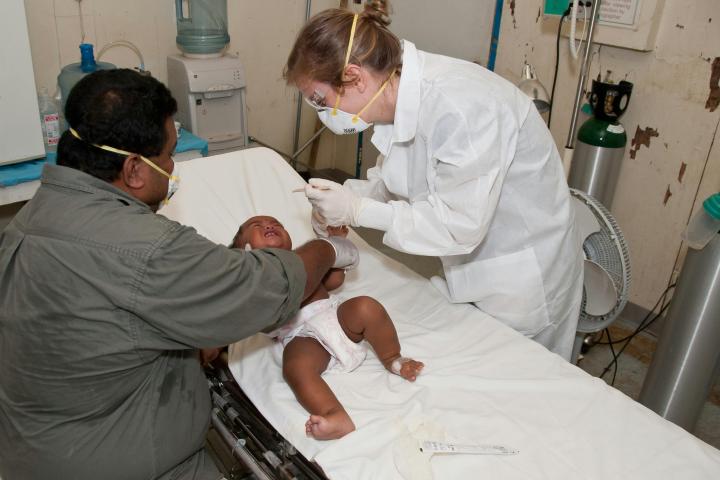
Healthcare Insights: Health and Climate Change
John August
While it likely comes as no surprise, the effects on human health from climate change are greater than most of us realize.

“Nowhere are the effects of climate change manifesting more clearly than in human health. Although many people consider climate change a looming threat, health problems stemming from it already kill millions of people per year. It is well established that rising levels of greenhouse-gas emissions, which cause climate change, also cause or exacerbate myriad health problems associated with air pollution, severe weather, wildfires, extreme temperatures, changes in vector ecology, and disturbances in the food supply, among other stressors. Furthermore, these health threats are not evenly distributed or experienced across geographies or populations: they disproportionately affect the most vulnerable and disadvantaged groups. The climate crisis is thus a public health and equity crisis that, absent concerted action, will continue to pose significant threats to human health.” (“Decarbonizing the U.S. Health Sector — A Call to Action”, Victor J. Dzau, M.D., Rachel Levine, M.D., George Barret, M.B.A., and Andrew Witty, B.A. New England Journal of Medicine, December 2, 2021).
In this issue of Healthcare Insights, we want to understand yet another of the many challenges we face as a society when it comes to the need to fundamentally reform healthcare delivery. In doing so, we do not wish to add to what seems like an already overwhelming sense of complexity. Instead, we should continue to explore ways in which we must see health and health care as a system that needs long term strategy and action for improvement.
There is much good work going on to positively impact the challenge of climate change generated from the healthcare industry, including strategies and implementation of excellent practices with important results as well. We’ll look at some of this progress, but first let’s understand the issues related to the healthcare industry’s contributions to the climate change crisis.
- “In the United States, the healthcare industry contributes about 10% of all greenhouse gas emissions
- The sectors contributing the most to carbon emissions in the health system are hospital care (36%), physician and clinical services (12%), and prescription drugs (10%). The Greenhouse Gas Protocol offers another way to look at GHG emissions, categorizing them as:
- Scope 1: Emissions from sources owned or directly controlled by the health sector, including emissions from health care facilities, such as on-site boilers and certain medical gases. These emissions account for around 7 percent of health sector emissions overall.
- Scope 2: Indirect emissions from the generation of energy purchased by health systems, mostly electricity. These account for around 11 percent of emissions related to health care.
- Scope 3: All other indirect emissions from the production and transportation of goods and services procured by the health sector, such as those related to pharmaceuticals and other medical products and devices. These account for more than 80 percent of overall health care emissions.
While health systems exert direct control over Scopes 1 and 2 emissions, they can only influence, not control, Scope 3 emissions, by far the largest source of GHGs produced by the health sector. Understanding the different sources of emissions and where health systems could have the most influence is key to deciding how to begin reducing health care’s carbon footprint.” (Source: Commonwealth Fund Explainer, April 19, 2022)
The challenges are well known and have been understood for some time.
The good news is that there are well established “roadmaps” for health care systems and providers to achieve the national goals to reduce greenhouse gas emissions by 50% by 2030 and to achieve net zero emissions by 2050. Such a roadmap can be found at the Agency for Health Care Research and Quality from September 2022.
The major contributors to greenhouse gas emissions include:
- Energy
- Transportation
- Anesthetic Gases
- Pharmaceuticals
- Medical Devices and Supplies
The above “roadmap” is just that. If followed by all healthcare organizations, the challenging goals cited above (50% net zero by 2030, and 100% by 2050) can be met.
It is also the case that health care in the U.S. is in deep crisis with out-of-control costs, historic workforce shortages, widening gaps in health equity based on race, ethnicity, and class. Though the U.S. spends at least twice as much on health care, our nation ranks last among OECD nations in population health. One might ask: how can healthcare try to tackle yet another major crisis?
The answer is that we must see the crises as intertwined. We have discussed in previous issues of this column the concept of Social Determinants of Health: that only 20% of our population’s health is determined by the healthcare system itself, and 80% of health is related to income, environment, housing, education, and access to healthy food and active living.

“Climate change and people’s health are inextricably linked. As a health care organization we see the negative impacts and know we need to lead and act quickly,” said Greg A. Adams, chair and chief executive officer of Kaiser Permanente. “It is our collective moral obligation to reduce our own emissions, protect the health of our communities, and support the vulnerable populations who are most impacted by climate change. We ask others to join us in our pledge, so together we can create a healthier, more equitable, and sustainable path forward.” (Source: Kaiser Permanente).
The good news is that major health systems are taking concerted strategic action. Kaiser Permanente, among the largest systems in the country was the first health system to achieve net-zero emissions in 2020.
Around the nation, health systems are committing the strategic resources and leadership to achieve the net zero goals (Source: U.S. Department of Health and Human Services).
New York State’s largest health system, Northwell Health has joined with at least 60 other major health systems in the climate change battle: “When you think of health care, so many times it’s the emergent issues of the day that come to mind. But the reality is that community health is a long game that requires strategic thinking and investments with an eye to the future,” said Michael J. Dowling, Northwell’s president and CEO. “Northwell Health has pledged to root out health disparities of all types – and that includes addressing our own impacts on the climate.”
Commitments are increasing. The roadmap is well known and successful.
Central to any enterprise-wide strategy requires the engagement of the entire staff of the organization. After all, who will carry out the work to create, build, and sustain the organizational commitment to achieving the goals of eliminating the health care sector’s greenhouse gas emissions as well as taking the industry green in a sustainable way?
Here are some wonderful examples of how unionized healthcare workers and health systems have collaborated in these important areas.
SEIU 1199 Northwest’s Training and Education Fund has developed a successful and exciting program for the training of Environmental Service Technicians. In so doing, not only are skills learned to better eliminate waste and enhance the achievement of green goals, but the importance of the issues and the essential contribution of the workforce is honored with recognition and pay increases.
Please watch this video about the program.
And here is a very inspiring, brief video about the education and consciousness raising among environmental service workers at Kaiser Permanente.
We have learned that climate change negatively impacts everyone’s health NOW, not tomorrow. For many of us, solving the climate crisis seems overwhelming and hard to integrate into daily living.
The story of how the healthcare industry must transform to best serve the entire population must include transformation of the role of all workers in the industry. After all, implementation of new processes, new equipment, new technologies, research and development, and new work processes will all be enhanced by engagement of the people who must carry out the transformation. Additionally, as the workforce is engaged in the strategies to eliminate greenhouse gases and other forms of harm to the environment, they will have many ideas about how best to achieve success.
“Engaging workers as partners requires new management styles built on collaboration and open dialogue. Younger generations are dissatisfied with a hierarchical approach to management and will seek out employers who engage them collaboratively. As part of the transition to a new style of leadership, there should be a focus on active listening and facilitative behaviors that elicit different viewpoints and encourage all participants to engage.
At the same time, business leaders need to play a key role in rebuilding dialogue with labor leaders in their communities and industries. Engagement with others outside of the internal organization is the best way to build a more inclusive social contract and empower a future of work that works for everyone”(Source: MIT Sloan School of Management).
We face long odds and lack of time to achieve the reforms in the healthcare delivery system. Rather than seeing the challenges separately, they must be tackled in a holistic fashion. Engagement of the workforce is essential to that holistic approach and success.
John August is the Scheinman Institute’s Director of Healthcare and Partner Programs. His expertise in healthcare and labor relations spans 40 years. John previously served as the Executive Director of the Coalition of Kaiser Permanente Unions from April 2006 until July 2013. With revenues of 88 billion dollars and over 300,000 employees, Kaiser is one of the largest healthcare plans in the US. While serving as Executive Director of the Coalition, John was the co-chair of the Labor-Management Partnership at Kaiser Permanente, the largest, most complex, and most successful labor-management partnership in U.S. history. He also led the Coalition as chief negotiator in three successful rounds of National Bargaining in 2008, 2010, and 2012 on behalf of 100,000 members of the Coalition.



